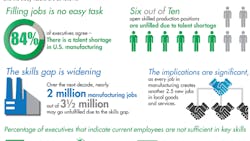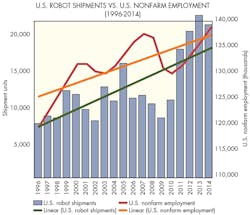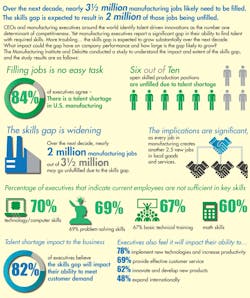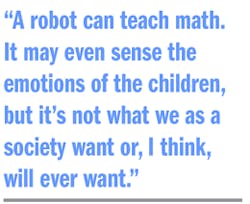This file type includes high-resolution graphics and schematics when applicable.
Replacing humans with machines has been happening for over a century. People often meet change and technology with resistance, and it’s usually fueled by lack of knowledge, concern for job security, or complacency with current technology. With the rise in automation and the Industrial Internet of Things (IIoT), many are still worried about job security and the ever-encroaching technology. But is this a valid concern?
Production and Labor
“The real threat to jobs is the inability to remain competitive.” Jeff Burnstein, President of the Association for Advancing Automation (A3) explains, “If you can’t compete, you only have a few choices—you send it overseas, you shut down, or layoff.” Automation can keep jobs from ever moving overseas, and often, new technology wins new business, too (see “Avoiding Workplace Hazards through Ergonomics”).
Not only can automation streamline production to help companies stay in business and even expand, but it can bring new talent to the table as well. Automation draws dynamic, skilled, employees—people who are excited about learning to use robots.
“We’re now able to attract people who aren’t just looking to draw a paycheck, but looking for a career,” says Matt Tyler, president and CEO of Vickers Engineering. Jordan Klint, senior automation engineer adds, “In order to bring young people into the business, you must have technology.”
A company with technology and talent must also improve production. It comes down to a ratio of labor or cost to production that has been around for many years. One example dates back to the early 1800s.
“There were reports saying that it would be impossible to get more than 20% of population off the farm because you can’t grow enough food for everyone,” says Mark Tarpenning, a partner at Wardenclyffe Partners. “Today, the U.S. has about 1% of our workforce on the farm while producing enough food for our country and others.”
Improving productivity is important in order to grow and become richer as a society. Technology is one of the proven ways to leverage that productivity. However, technology wasn’t always great with increasing the productivity-to-cost ratio.
Automation in the 1960s through the 80s was very mechanical and forced. Part of the reason was that designers were trying to have machines act or move like humans. Over time, designers started developing processes that worked better with machines so that they could work more efficiently. Still, this involved expensive and highly custom-built equipment.
More recently, the focus on electronics and software has allowed more flexibility and options in automation and robotics. This may be why people are concerned for job security. However, says Tarpenning, “the goal of using equipment or tools, in general, is to produce a better product, not necessarily replace workers or take jobs.”
Drivers and the Bottom Line
In fact, according to Deloitte—an audit, consulting, and financial advisory company—there will be 3.5 million available manufacturing jobs from 2015 to 2025, and about 2 million of them will go unfilled due to a skills gap. In 2011, 600,000 jobs went unfilled due to the skills gap. If this trend continues, robotics and automation might be the only way companies will be able to fill orders.
Much of our competitive advantage comes from the technicians and engineers who have years of experience. However, economicmodeling.com wrote in 2014: “Yet if demand for workers [engineers] continues and if a good-sized segment of that workforce is poised to retire, skills gaps are likely to become a real issue—especially at senior- or management-level positions that are hard to recruit for.” If engineers are retiring faster than students are entering the field, and potentially missing the opportunity to learn from them, we might lose valuable knowledge as time progresses.
One group that might be aided by automation and robotics is skilled workers in service jobs. The Bureau of Labor Statistics published that there was an increase in service jobs, but a drop in manufacturing. While some jobs are returning to the states, the Labor Department estimates jobs will continue to fall, just at a much slower rate.
In March 2016, professional and business services saw an increase in 33,000 jobs. Though not a significant number for this particular industry, it represents a significant jump considering manufacturing jobs decreased by 29,000. “The majority of the careers that the skilled labor force has been seeking in recent years are service-related, which suggests a harsh reality,” says Burnstein, President of A3. “Manufacturing is no longer one of the nation’s most coveted career paths for those entering the workforce.”
As more manufacturing jobs return to the U.S., the skills gap remains a concern. The Boston Consulting Group (BCG) studied 10 years of data (2001 to 2014) from the 25 countries that account for nearly 90% of the world’s exports of manufactured goods. It wanted to understand the economics driving global sourcing decisions. The group found four key factors that significantly affect manufacturing location decisions.
• Manufacturing wages
• Labor to productivity
• Energy costs
• Exchange rates
These four factors also improved in terms of cost competitiveness in the U.S. over those 10 years. They indicate that while some jobs have already returned to the U.S., it looks like more will return over time.
The Opposition
With all that said, we need to address that elephant in the room: If our world’s population continues to grow, and overall world jobs shrink, how much longer can reshoring sustain a world economy? Manufacturing can reshore by replacing 10,000 workers overseas with 1,500 workers in the U.S., but this seems to all lean toward one direction—the end of unskilled labor while the unskilled laborer workforce grows worldwide.
For example, Cambodia offers low-skill cheap labor, but technology is changing that paradigm. Recent developments in 3D printing, robotic automation, and more look poised to replace workers in the Cambodia garment sector. According to 3DprintIndustry.com, “A new report warns that the majority of Cambodia’s garment sector workers could lose their jobs within the next 20 years, as innovative technologies and automated systems replace low-skilled labor.”
A study conducted by the International Labour Organization (ILO) found that 88% of Cambodia’s textile, clothing, and footwear workers were at a high risk of being replaced with automated machinery. In addition, some countries, like Cambodia, will feel a stronger impact where textile, clothing, and footwear production dominates an undiversified manufacturing sector and makes up around 60% of manufacturing employment.
“Most of the country’s labor force is young, but often not equipped with skills that match business needs, so the challenge for policymakers is to address this gap and mismatch,” said Asian Development Bank’s Chief Economist Shang-Jin Wei while moderating a panel on policy recommendations for Cambodia. “Developing a more educated, employable, and productive workforce is essential for Cambodia…” It seems impossible to avoid technology and maintain an economy, so a key factor is to educate.
Employees with job security may be those who build and program the robots. However, John Rinaldi, CEO of Real Time Automation Inc., says, “Humans are exceptionally good at leadership, social collaboration, goal setting, teaching, coaching, encouraging, and selling. These are innate, very human skills that possibly could be replaced by automation but that we don’t want replaced. A robot can teach math. It may even sense the emotions of the children, but it’s not what we as a society want or, I think, will ever want. We’ll always want and value these soft skills.”
If you are still worried, remember how William Bossert, legendary Harvard professor, summed it up by saying, “If you’re afraid that you might be replaced by a computer, you probably can be—and probably should be.” While it may not be comforting, it could be a wakeup call for continued education.
Currently, the top growing jobs, according to CareerBuilder and Economic Modeling Specialist International, are software developers, market research analysts and marketing specialists, training and development specialists, financial analysts, physical therapists, and web developers. Missy Rogers, president of Noble Plastics in Grand Coteau, LA, succinctly wraps up the conversation with: “Exploit technology, not people. Low-cost labor exploits people. An efficient manufacturer exploits technology.”





